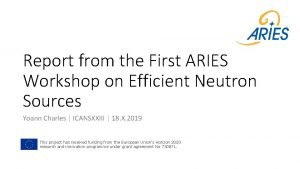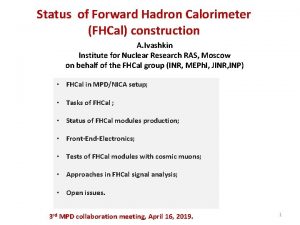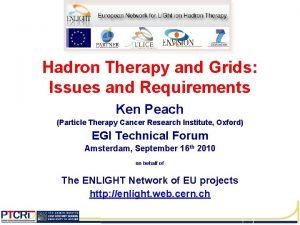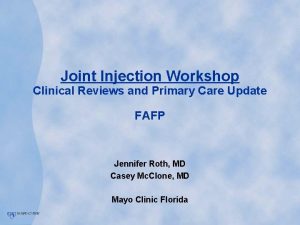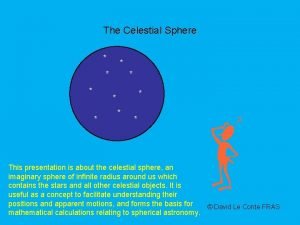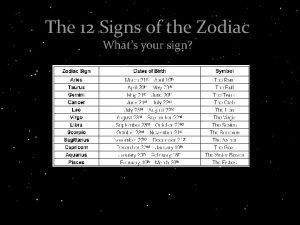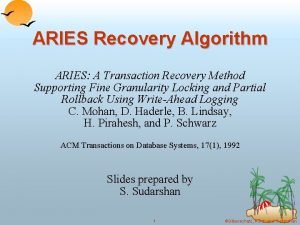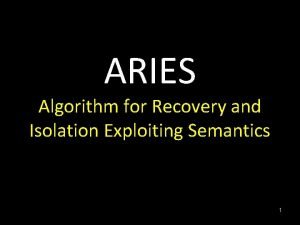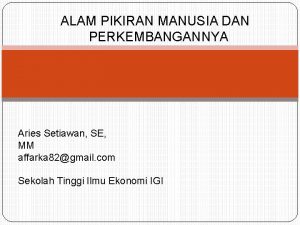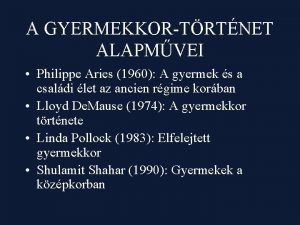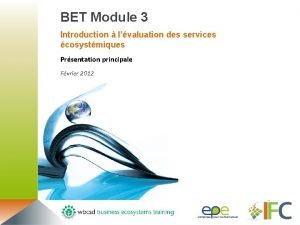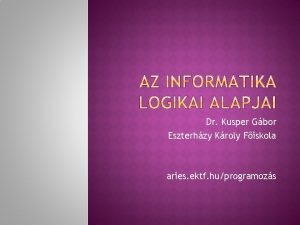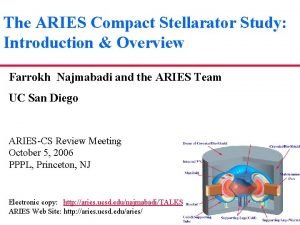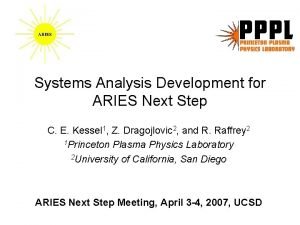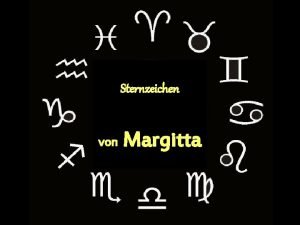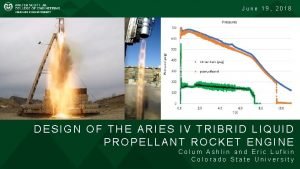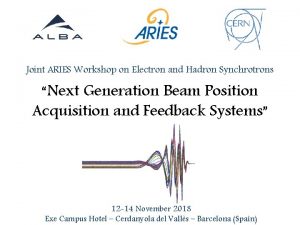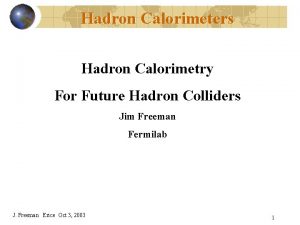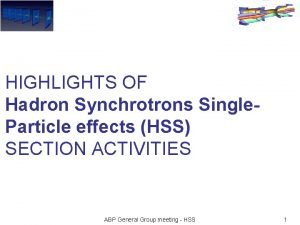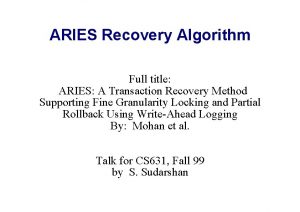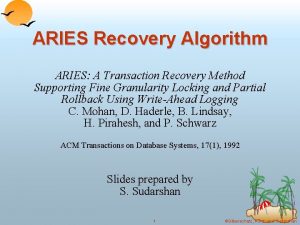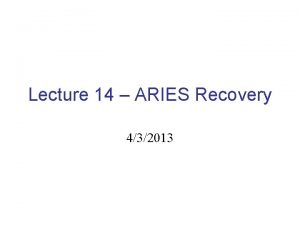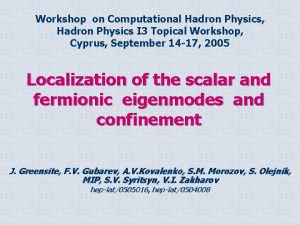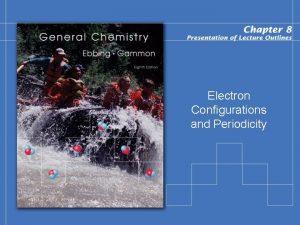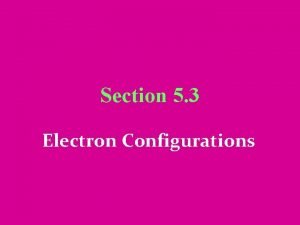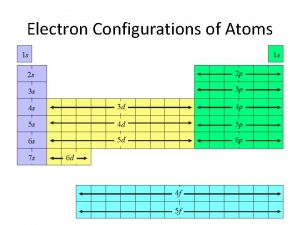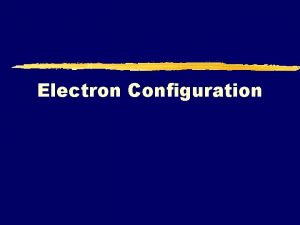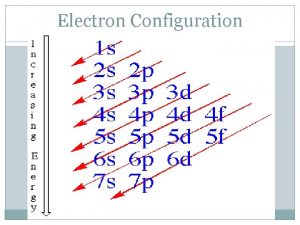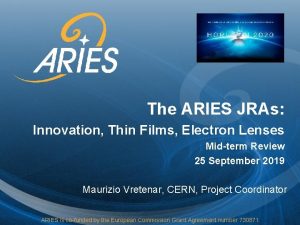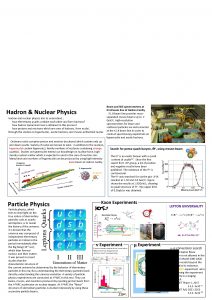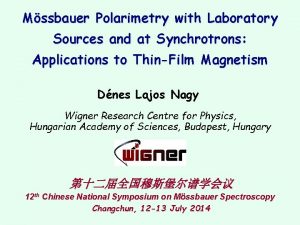Joint ARIES Workshop on Electron and Hadron Synchrotrons






































- Slides: 38

Joint ARIES Workshop on Electron and Hadron Synchrotrons Barcelona, 12 -14 th November 2018 Digital Electronics & DAQ for FAIR Algorithms for position calculation and achievable resolution A. Reiter & R. Singh (GSI) for the Dept. of Beam Instrumentation Acknowledgements to K. Lang, O. Chorniy, P. Miedzik, P. Kowina, P. Forck (GSI) D. Tavares (LNLS) 1 Facility for Antiproton and Ion Research in Europe

Outline of talk Facility for Antiproton and Ion Research in Europe § Motivation § BPM systems at GSI & FAIR § Beam position in time-domain analysis § Asymmetry measurement (Δ/Σ) § Comparison of „classical“ estimators and least-squares fit of (Δ/Σ) tuples § Model prediction of position uncertainty § Experimental verification: applications and tests § Bunch and orbit position uncertainty § Robustness of position and tune spectra § Multi-turn injection & coasting beam § Detour on electron machines: comparison to IQ demodulation § Conclusion & Outlook 2

Motivation BPM systems at GSI Facility for Antiproton and Ion Research in Europe SIS 18 ESR „High-energy“ BPMs at GSI SIS 18: 12 shoe-box (125 mm) CRYRING closed-orbit FB ESR: 12 shoe-box (250 mm) Transfer SIS-ESR: 10 (not in regular operation) CRYRING: 9 diagonal-cut cylinder (100 mm) 3

Motivation BPM systems at FAIR Facility for Antiproton and Ion Research in Europe FAIR = massive increase in BPMs (number, systems, complexity of HW & SW) SIS 100 (1080 m) SIS 18 (216 m) ESR (108 m) SIS 100 HEBT CR HESR p. Linac 4 84 cryo-BPMs, diag. -cut closed-orbit feedback ~50 diag. -cut (150/[400] mm) 19 elliptical (400 x 200 mm) 76 diag. -cut (90 mm) 15 button pickups HESR CR HEBT transfer lines and secondary target stations (~35 beam lines)

Motivation Extremes of FAIR machines Facility for Antiproton and Ion Research in Europe SIS 100 (100 Tm) p. Bar Production CRYRING (1. 44 Tm) March 2018 test Beam protons Magnesium Mg 1+ No. of particles 2. 5 x 1013 ~1 x 10[6 -8] Energy 30 Ge. V 32 ke. V/u (max. energy) Harmonic number 10 → 1 18 Pulse length ~500 – 50 ns few µs Electrode signal ~2000 Volt µV – tens of m. V Front-end electronics • 18: 2 matching transformer • (-50 – 60) d. B amplifier • BW = (0. 04 – 7/55) MHz • High-impedance +40/60 d. B amplifier • BW = (0. 01 – 4/40) MHz Data acquisition 250 MSa/s ADC (± 1 Volt, 16 bit, ENOB= 12) 125 MSa/s ADC (± 1 Volt, 16 bit) RF gymnastics bunch merging & compression (SIS 100), bunch rotation & stochastic cooling (CR), longitudinal slip stacking (HESR) 5

Position measurement Real signals from SIS 18 § § Facility for Antiproton and Ion Research in Europe DAQ hardware : 125 MSa/s, 14 bit ADC, ENOB~10 (Libera Hadron Platform A) TOPOS system: integral with baseline restoration and dual-threshold detection Injection mismatch (8. 6 Me. V/u) Vpp ~1% FS (full scale) § After acceleration to 300 Me. V/u Vpp ~50% FS Bunch quality differs strongly throughout cycle: Baseline restoration or bunch detection difficult or unreliable. Ideally, new analysis is independent of bunch shape. General question: How can we predict the uncertainty of a bunch or orbit position? § 6

Position measurement Approach of evaluation § 7 Facility for Antiproton and Ion Research in Europe

Position measurement Approach of evaluation Facility for Antiproton and Ion Research in Europe Any function f(c • S) = c • f(S) is eligible, even better: f(c • S + offset) = c • f(S) But which candidate is „optimal“, at least for us? peak value (Smax) integral of absolute value |S| integral after baseline restoration (INT) ……. . root-sum-square (RSS) standard deviation (STD) define empirical requirements for “optimum” result We overlooked STD initially ! judge by robustness (behaviour, characteristics) & uncertainty evaluate direct digitisation by a linear system in time-domain Synchrotron or beam line BPM (or linac button) FAIR: Matching transformers 8

Time-domain model “Classic” (Δ/Σ) approach Facility for Antiproton and Ion Research in Europe § Analytical calculation - for arbitrary position - with & w/o baseline droop - for INT, RSS, STD 9 Uncertainty depends on offset / baseline droop!

Time-domain model Least-squares fit Facility for Antiproton and Ion Research in Europe § Scatter plot 10

Time-domain model Analysis properties Classical approach Least-squares Coordinate system Position weight Facility for Antiproton and Ion Research in Europe Integral RSS STD constrained fit direct proportion straight line absolute relative / floating Σ Need for - baseline restoration yes no no - ADC zero adjustment no yes no - AC coupling (baseline droop) no yes - random offsets no no yes - low-frequency distortion (for small amplitudes) no no Tolerance to 11

Time-domain model Achievable resolution § § Facility for Antiproton and Ion Research in Europe Uncertainty comparison for centred, triangular pulse Example: straight-line fit § § 12 Analysis parameters § no. of signal samples NS § no. of baseline samples NB SIS 18 hardware parameters § noise σV = 1 m. V § full scale VFS = 2 Volt § signal amplitude A = 0. 5 FS § sensitivity s. V = 2 (%/mm) equiv. to diag. -cut cylinder (s = 1/r) of r = 50 mm radius FAIR: 250 MSa/s is sufficient for smallest 50 ns pulse length, yielding ~13 samples (requirement σx/y< 0. 1 mm)

Experiments (flat top) Uncertainty comparison Facility for Antiproton and Ion Research in Europe Experiment conditions § Data taken after acceleration to 300 Me. V/u § Vertical BPM: pulse shape (NS~13) as in slide 8 (A= 0. 5), sensitivity s. V = 2 (%/mm) § Analysis: Include increasing number of bunches to statistically simulate larger number of signal samples, for a case where expected uncertainties are similar Result § Simple model seems to provide reasonable estimates § Only straight-line fit approaches theoretical limit for NS >40 § σy(short bunch) < 0. 05 mm or σm = (σy • s) < 1 x 10 -3 13

Experiments (flat top) Orbit uncertainty & robustness § § Facility for Antiproton and Ion Research in Europe 300 Me. V/u data (hor. BPM, s. H= 0. 8%/mm, 10000 samples/fit ~ 75 turns, A= 0. 3) Add distortion to one electrode signal in analysis and calculate offset to raw data Result: Orbit uncertainty <10 µm; RSS and direct proportion sensitive to distortions 14

Experiments (flat top) Horizontal tune & robustness Integral + baseline restoration Amplifier effect: Not present in tune spectra of other BPMs § 15 gain regulation tune line Facility for Antiproton and Ion Research in Europe RSS added sine wave Straight-line fit

Experiments (start of cycle) Orbit by asynchronous mode Facility for Antiproton and Ion Research in Europe § Asynchronous mode: Data stream of fit results for fixed number of samples 200 samples/fit = 625 k. Hz stream (3125 positions in 5 ms) „observer“ mode: no external signals, no bunch detection, … § Check positions after multi-turn injection in SIS 18 for direct prop. and straight-line raw data Vpp~ 4% FS Result: RSS yields slightly larger jitter, its uncertainty shows outliers / asymmetric tail 16

Experiments (start of cycle) Asynchronous mode vs SIS 18 TOPOS Note: different trigger time compared to previous slide Facility for Antiproton and Ion Research in Europe Result: § Asynchronous mode „locks“ quickly onto bunch signal and exceeds TOPOS performance § Dual-threshold detection needs minimum bunch quality to start tracking of positions Δ / Σ signals in 10 µs interval Vpp(Sum)= 80 ch. / 0. 5% FS 17

Experiments “Exotic“ applications § § Multi-turn injection from UNILAC injector Turn-by-turn position evaluation using standard deviation (STD) Last injected turn dominates position due to fast decay of structure Reproduction of design offset due to injection bumper 9 -turn injection fast decay of 36 MHz structure 18 Facility for Antiproton and Ion Research in Europe

Experiments “Exotic“ applications § Coasting high-intensity beam (400 Me. V/u, Xe 43+, 11 m. A DC current) with orbit bump § Position calculation by straight-line fit after FFT filter on revolution frequency and higher harmonics (up to 20) § Confirmation by IPM profile monitor Facility for Antiproton and Ion Research in Europe RF cavity detuning off coasting beam Region A: Amplifier overload ( ⇒ positions not correct) for all position, but 5 mm data where we used a smaller gain! 19 R. Singh et al. , accepted for publication in Rev. of Sci. Instr. https: //doi. org/10. 1063/1. 5063324

Simulation Comparison to IQ demodulation Facility for Antiproton and Ion Research in Europe § BPM system for Sirius light source (by courtesy of D. Tavares, LNLS) § Simulated ADC raw data analysed as turn-by-turn blocks using STD § Results of both approaches in good agreement https: //wiki-sirius. lnls. br 20

Simulation Comparison to IQ demodulation Facility for Antiproton and Ion Research in Europe § BPM system for Sirius light source (by courtesy of D. Tavares, LNLS) § Simulated ADC raw data analysed as turn-by-turn blocks using STD § Results of both approaches in good agreement 21

Conclusion & Outlook § § § 22 Facility for Antiproton and Ion Research in Europe Review of position analysis for a linear system in time-domain § “Practical” statistical model: position uncertainty & robustness § Straight-line fit (or STD) provides good robustness and resolution, matching model prediction (more information: A. Reiter, S. Singh, NIM A 890 (1018) 18 -27 and “ar. Xiv 1609. 01332”) New approach has led to significant improvements (and some new applications) § smaller measurement uncertainty § orbit position stream via asynchronous mode in extended interval in cycle § analysis of tune, multi-turn injection and coasting beam pilot test § was compared to simulated data for Sirius BPM system § can be applied to linac buttons Development status / realisation § CRYRING: Straight-line fit (and averaging) stage implemented on FPGA bunch-by-bunch position via RF clock signal § SIS 18: Direct proportion § FAIR: Tests at SIS 18 (incl. COFB) and ESR, position calculation options: bunch detection & integral / narrow-band analysis / user-defined calc.

Finally, … I show some room for improvement Facility for Antiproton and Ion Research in Europe and thank the organisers for the invitation … …. . and everyone of you for your kind attention ! 23

Facility for Antiproton and Ion Research in Europe Spare slides 24

Rendering of FAIR Research Campus 25 Facility for Antiproton and Ion Research in Europe

FAIR BPM system Data paths Custom algorithm 26 Facility for Antiproton and Ion Research in Europe

Time-domain model Analytic formulae 27 Facility for Antiproton and Ion Research in Europe

Experiments (flat top) SIS 18 cycle § 28 Facility for Antiproton and Ion Research in Europe

CRYRING BPM system Data path § § § Facility for Antiproton and Ion Research in Europe µTCA open-hardware system with FAIR timing receiver node (FTRN) 125 MSa/a, 16 bit, +/- 1 Volt input range RF clock input for turn-by-turn fits (or maximum of 1023 samples) RF clock signal !!! No filter stage !!! calibrated data 29 turn-by-turn position orbit positon

Signal Examples Facility for Antiproton and Ion Research in Europe § SIS 18: 125 MSa/s, 14 bit ADC, Platform A Injection mismatch CRYRING: 125 MSa/s µTCA DAQ Mg+ „bunches“ after acceleration gain +60 d. B, 4 MHz filter RF gate 300 Me. V/u BPM sum (60 d. B) Resolution: 2 m. V / div 1 µs / div ICT (80 d. B) 30

Facility for Antiproton and Ion Research in Europe 31

Facility for Antiproton and Ion Research in Europe 32

Facility for Antiproton and Ion Research in Europe 33

Our latest child CRYRING – a low energy synchrotron Facility for Antiproton and Ion Research in Europe § § 1. 44 Tm storage ring 54 m circumference mainly for atomic physics Storage of cooled heavy ions from experimental storage ring ESR § Electron cooler and laser facility § Research opportunities to study interaction of heavy ions, electrons and photons … and other reasearch Atomic Nuclear and particle Material Science Accelerator Physics … … GSI Helmholtzzentrum für Schwerionenforschung Gmb. H 34

Parallel Operation New Beam Line Network § § „Design ions“: proton and U+(28 / 73 / 92) Other ions: C, N, Ne, Ar, Ni, Kr, Xe, Au, etc. SIS 18 & SIS 100 beams for users Slow / fast extraction: 10 -30 s / 30 -100 ns § Nu. STAR § U 28+; 1 Ge. V/u, 3 x 1011 to fixed target § U 28+; 1 Ge. V/u, 70 ns, 5 x 1011 to CR CBM § U 92+; 10 Ge. V/u; 1. 5 x 1010; 10 s spill p. Bar Production § p ; 30 Ge. V; 2. 5 x 1013; 50 ns APPA § Bio. Mat, SPARC: highly charged ions up to 10 Ge. V/u; slow extraction § Plasma Physics: see Nu. STAR; 1 shot every 2 minutes (PHELIX laser) FLAIR (ESR/CRYRING/HITRAP) § Highly charge ions § Deceleration 4 Me. V/u – 500 ke. V/u – 6 ke. V/u § Trapping of ions for experiments § § 35 Facility for Antiproton and Ion Research in Europe

Parallel Operation The Underground Map § § 36 Parallel operation to supply several users simultaneously Complex pattern of beam chains to be implemented White Rabbit Timing system (CERN) and Bu. Ti. S Bunch Timing system Bu. Ti. S (GSI) and an effective beam scheduling logic will be most crucial More than 60 timing domains Facility for Antiproton and Ion Research in Europe

p. Bar Beam Production Beam Pattern § § Facility for Antiproton and Ion Research in Europe Design luminosity L = 2 x 1032 cm-2 s-1 (100 mb total inelastic p. Bar-p cross section: 2 x 107 s-1 consumption) p-Linac produces 4 pulses of 70 Me. V proton beam in ~1. 2 s (2. 5 Hz) SIS 18 accelerates each pulse to 4 Ge. V and needs ~1. 6 s, including pre- and postprocessing SIS 100 § Injection of 4 batches from SIS 18 needs ~1. 2 s, yields ~2 x 1013 protons § Merging into one single bunch, acceleration to 28. 8 Ge. V/u § Compression to bunch length of ~30 ns § Cycle length ~2. 7 s in MSV with reduced no. of RF cavities, 2. 55 s in final setup Cooling in CR § Bunch rotation to reduce momentum spread (Δp/p ± 3%) § Adiabatic de-bunching § Stochastic cooling down to p/p 0. 1%, Emittance(h, v) ~5 pi mm mrad § Repetition time 10 s Accumulation in HESR § Accumulation of 1 x 1010 antiprotons in 1000 s § Decelerate/accelerate § Beam on target for ~1000 s § § 37

p. Bar Beam Production Example Beam Chain 38 Facility for Antiproton and Ion Research in Europe
 Aries workshop
Aries workshop Hadron calorimeter
Hadron calorimeter Hadron collider
Hadron collider Hadron collider
Hadron collider Hadrons
Hadrons Hadron
Hadron Is riveting permanent or temporary
Is riveting permanent or temporary Plane joint
Plane joint Joint injection workshop
Joint injection workshop Lamb grading
Lamb grading Membrana tectoria
Membrana tectoria Memorandum of joint venture
Memorandum of joint venture Lamb grading chart
Lamb grading chart Aries in dbms
Aries in dbms Hour angle
Hour angle Leo strengths and weaknesses
Leo strengths and weaknesses Piscis + tauro
Piscis + tauro Aries transilvania
Aries transilvania Aries blueprint
Aries blueprint Aries algorithm
Aries algorithm Opie childhood sociology
Opie childhood sociology Lindsey bleimes
Lindsey bleimes Aries recovery algorithm
Aries recovery algorithm Ares personality
Ares personality Aries nature
Aries nature Aries 1960
Aries 1960 Signo de risa
Signo de risa Aries bcsd
Aries bcsd I'm an aries
I'm an aries Que odia aries
Que odia aries Aries y tauro
Aries y tauro Aries magyarul
Aries magyarul Aries horscopo
Aries horscopo Aries
Aries Aries analysis
Aries analysis Aeries portal sylvan
Aeries portal sylvan Berühmte widder
Berühmte widder Aries database
Aries database Aries iv
Aries iv
